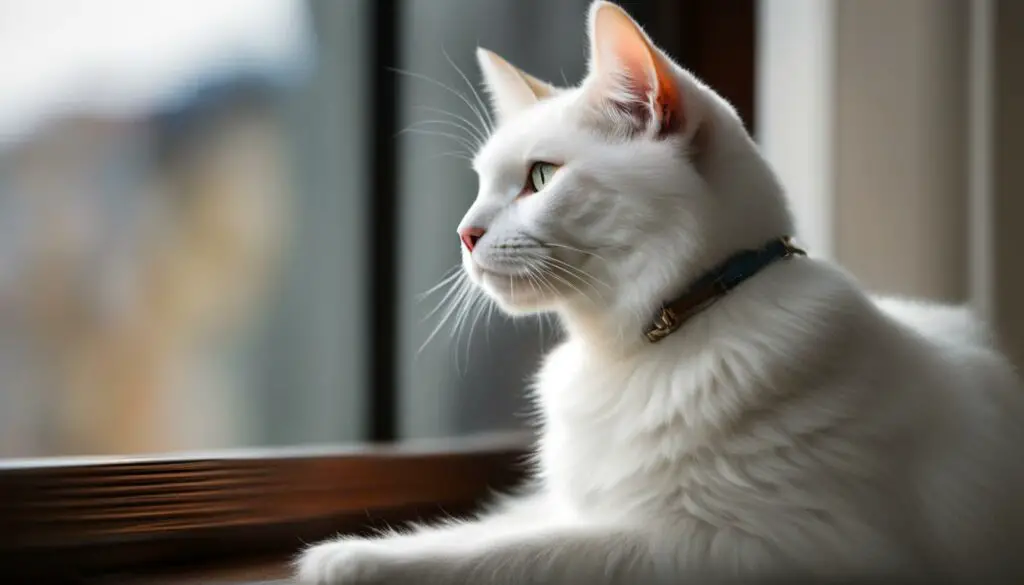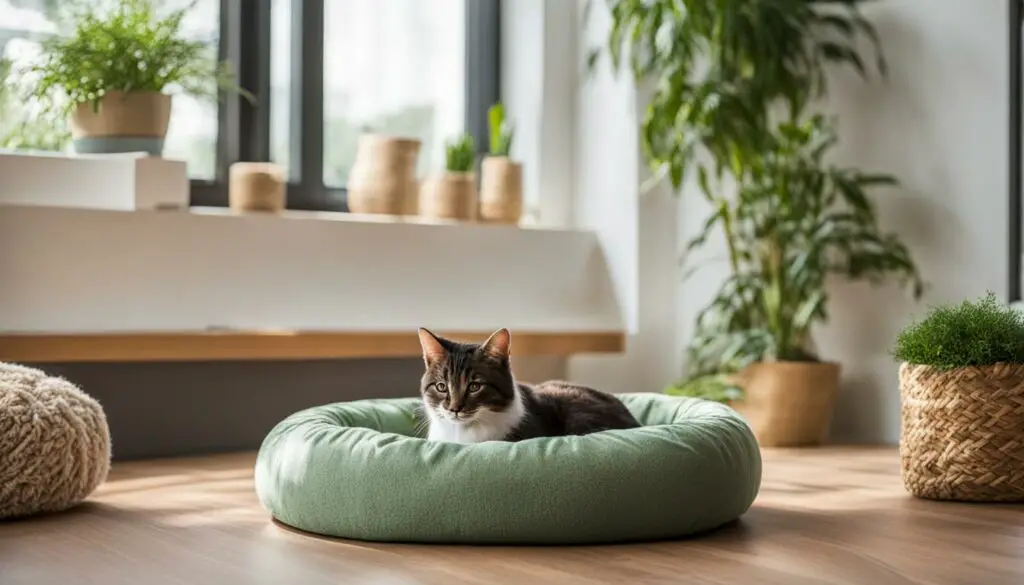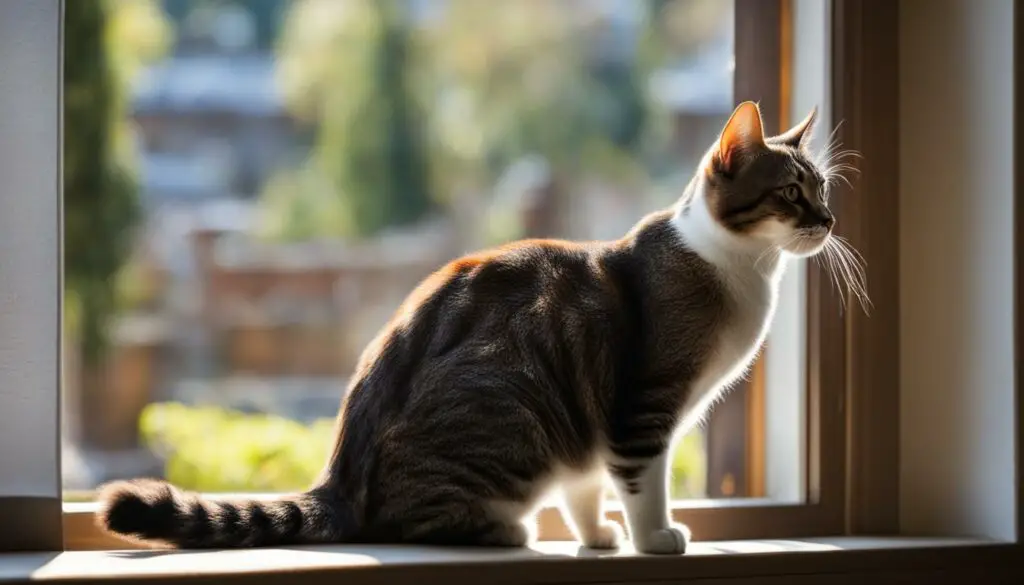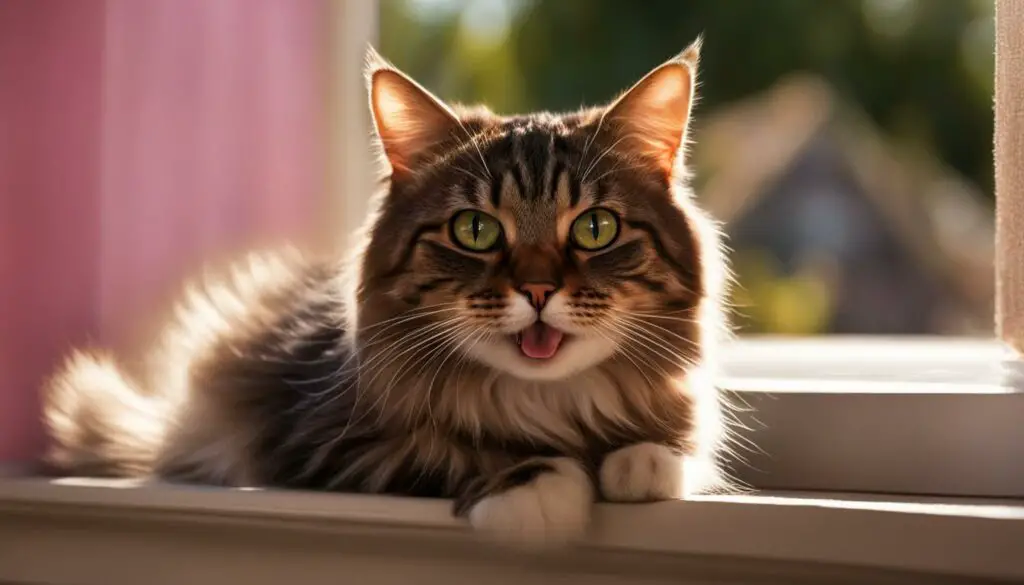Have you ever wondered why your cat meows when you sing? It’s a puzzling behavior that many cat owners experience. Cats are mysterious creatures, and their response to singing is no exception. Let’s explore the fascinating reasons behind why cats meow when their owners serenade them.
Key Takeaways:
- Cats meow when their owners sing because they perceive it as a form of communication.
- Cats may prefer female voices due to their higher pitch, which is similar to a cat’s meow.
- Singing in a soft and melodic manner can create a calming environment for cats.
- Meowing in response to singing may be a way for cats to express their emotions and seek attention.
- Understanding your cat’s preferences and adjusting your singing style accordingly can strengthen your bond.
Cat Communication and Vocalization
Cats have a complex system of communication that includes vocalization. Meowing is one of the primary ways cats express themselves and communicate with their owners. When it comes to singing, cats may respond for various reasons, as they perceive it as a form of communication.
Meows can convey different meanings and emotions, such as a request for attention, food, or expressing discomfort. Singing may trigger a response in cats because they interpret it as an attempt to communicate with them. The melodic sound of singing might resonate with their instinctual understanding of communication.
Understanding cat communication and vocalization is important for cat owners to interpret their furry companions’ needs and emotions. By paying attention to their meows and observing their body language, we can develop a deeper understanding of our cats’ unique ways of expressing themselves.
Cat Communication and Vocalization
In order to better understand the reasons behind why cats meow when their owners sing, it is necessary to delve into the intricacies of cat communication and vocalization. Cats have a wide range of vocalizations, each serving a different purpose. Meowing is just one form of vocal communication, and it can have many meanings.
Cats use meowing to communicate with humans, specifically. They have learned that meowing can elicit a response from their owners, whether it’s getting attention, food, or simply expressing their emotions. Singing, with its melodic and rhythmic nature, can stimulate cats’ instinctual understanding of vocal communication, leading to their meowing in response.
It’s important to note that cats’ responses to singing can vary. While some cats may enjoy the interaction and respond positively by meowing, others may not show any noticeable reaction. Every cat is unique, and their individual preferences and experiences shape their responses to different stimuli.
| Forms of Cat Vocalization | Meaning |
|---|---|
| Meowing | Requesting attention, food, or expressing emotions |
| Purring | Sign of contentment, relaxation, or seeking reassurance |
| Hissing | Warning or feeling threatened |
| Growling | Intense warning or aggression |
“Cats have a unique way of communicating with their owners, and their response to singing can be seen as an attempt to engage in this form of communication.”
Overall, cat communication is a fascinating subject that requires careful observation and interpretation. By understanding the various forms of vocalization and the context in which they occur, we can better decipher our cats’ messages and respond accordingly.
Cats’ Preference for Female Voices
When it comes to cats and their response to singing, one interesting phenomenon that has been observed is their preference for female voices. Cats seem to be more receptive to the higher pitch and softer tones of female voices, which are closer in frequency to a cat’s meow. This preference for female voices can be attributed to the familiarity and comfort that cats associate with these sounds.
Research has shown that cats often respond positively to the gentle and soothing qualities of female voices. They perceive these voices as less threatening and more nurturing, which evokes a sense of trust and security in them. This may explain why cats meow when their owners, especially females, sing to them.
| Voice Type | Cat Response |
|---|---|
| Female | Positive and comforting |
| Male | Varied responses, depending on individual cats |
Table: Cat Response to Different Voice Types
As seen in the table above, cats generally have a more positive and comforting response to female voices compared to male voices. However, it’s important to note that individual cats may have unique preferences and may not necessarily exhibit the same response as others.
So, the next time you find your cat meowing when you sing, remember that they may be drawn to the familiar and soothing qualities of your voice, particularly if you have a higher-pitched female voice. It’s just another way for them to connect with you and feel comforted in your presence.

Cats’ Response to Soothing Sounds
When it comes to cats, they are highly sensitive to their environment, including the sounds around them. Many cat owners have noticed that their feline companions have a positive response to soft and soothing sounds, including singing. While each cat may have its own unique preferences, there are some common reasons why cats may meow when their owners sing to them.
Cats are known for their ability to pick up on subtle cues and emotions, and soothing sounds can create a calming atmosphere for them. Singing in a gentle and melodious manner can help create a sense of relaxation and contentment in cats. The combination of soft tones and rhythmic sounds may resonate with their natural instincts and provide a sense of security.
Additionally, cats may view their owners’ singing as a form of bonding and communication. The act of singing to them can be seen as an expression of love and attention, which cats often seek from their human companions. Meowing in response to singing may be a way for them to reciprocate the interaction and show their appreciation.
| Reasons Cats Meow When Their Owners Sing |
|---|
| Response to soothing and calming sounds |
| Perception of singing as a form of bonding |
| Expression of relaxation and contentment |
It’s important to note that not all cats will meow when their owners sing, as each cat has its own unique personality and preferences. Some cats may prefer silence or respond differently to other types of sounds or music. Therefore, it’s crucial to observe and understand your cat’s individual preferences and adjust your singing style accordingly.

Meowing as a Form of Expression
When cats meow in response to singing, it can be seen as their way of expressing their emotions or trying to communicate with their owner. Just like humans use words to convey their feelings, cats use meows to express themselves. Each meow can have its own unique meaning and intention, and it’s important for cat owners to understand and interpret these vocalizations.
Cats may meow when their owners sing as a form of interaction, seeking attention, or even mimicking the sounds they hear. For example, if a cat meows while their owner is singing a high-pitched tune, it could be their way of joining in the musical conversation. This kind of meowing can be seen as a playful expression of their enjoyment and desire to be part of the interaction.
The Meaning Behind Different Meows
Cats have a wide range of vocalizations, and each meow can carry a different meaning. Here are some common interpretations of cat meows:
- Attention-seeking meows: Cats may meow to get their owner’s attention, especially if they want to be fed, played with, or simply want some affection.
- Expressing discomfort: Meows can also indicate that a cat is feeling uncomfortable or in pain. It’s essential to pay attention to the context of the meow and any accompanying body language to identify if something may be wrong.
- Excitement or anticipation: Cats may meow when they are excited or anticipating something, such as the arrival of their owner, mealtime, or playtime.
Understanding the meaning behind your cat’s meows can deepen your bond with them and help you provide the appropriate care and attention they need. It’s a way for them to communicate their needs and emotions effectively.

Observing your cat’s behavior, body language, and context can provide valuable clues about what their meows are trying to convey. By paying attention to these vocalizations, you can respond appropriately and strengthen your connection with your feline friend.
The Role of Music in Cat Behavior
Music has a significant impact on cat behavior and can play a crucial role in creating a harmonious environment for our feline friends. Cats are known for their sensitivity to sound, and music, with its soothing and melodic qualities, can have a calming effect on them.

Cats are particularly responsive to soft and gentle tunes. The melodic sounds can help create a sense of peace and relaxation, reducing their stress levels and anxiety. Just like humans, cats can find solace in music, and it can even enhance their overall well-being.
Research has shown that certain types of music, such as classical or ambient melodies, can have a positive influence on a cat’s behavior. These genres tend to have a slower tempo and a more soothing rhythm, which can help cats to feel more at ease and content. Playing calming music during times of stress or when introducing a new environment can help cats adjust and feel safe.
The Benefits of Music for Cats
The benefits of music extend beyond relaxation for cats. It can also help stimulate their minds and provide enrichment. Soft music can create a background ambiance that encourages exploration and playfulness. Cats may become more engaged and curious in their surroundings when enjoying calming tunes.
| Benefit | Description |
|---|---|
| Reduced Stress | Soft music can help reduce stress in cats, creating a calming environment. |
| Mood Enhancement | Music can improve a cat’s mood and overall well-being. |
| Stimulation | Cats may become more engaged and curious in their environment when listening to soothing music. |
“Music has the power to soothe cats and create a serene atmosphere for them to thrive in.”
When using music as a tool to improve cat behavior or reduce stress, it’s essential to choose appropriate genres and volume levels. Avoid loud or jarring sounds that may startle or upset your cat. Paying attention to their reactions and observing their body language will help you determine which music they respond to positively.
The Science Behind Singing to Cats
When it comes to the intriguing behavior of cats, the science behind singing to them reveals fascinating insights into their reactions and emotions. Research has shown that singing to cats can have a calming effect, thanks to the combination of various factors. The higher pitch of female voices and the soothing nature of soft music contribute to cats’ positive response.
Scientific studies have explored the connection between singing and cat behavior. One study conducted by researchers at a renowned university observed cats’ reactions to different types of music. They found that when exposed to soft, melodic tunes, cats exhibited signs of relaxation, such as purring and reduced stress behaviors.
Singing to my cat has become a daily ritual that we both enjoy. It’s amazing to see how she responds to the music and the bond it helps foster between us.” – Cat owner
Another scientific explanation for singing to cats is that it mimics their communication styles. Cats use meowing as a way to express their needs, emotions, and desires. When their owners sing, cats may perceive it as an attempt to communicate with them. The rhythmic patterns and melodic tones in singing can resonate with a cat’s instinctual responses.
| Scientific Explanation: | Research Findings: |
|---|---|
| Singing mimics cat communication styles | Cats may perceive singing as an attempt to communicate with them |
| Higher pitch of female voices | Cats have shown a preference for female voices due to their similarity to the pitch of a cat’s meow |
| Soft and soothing nature of music | Cats respond positively to soft, melodic tunes, experiencing relaxation and reduced stress behaviors |
While the science behind singing to cats provides valuable insights, it’s important to note that individual cats may have different preferences and reactions. Some cats may not respond as positively to singing as others, emphasizing the need to understand and respect their unique personalities. By observing their reactions, adjusting our singing style, and creating a harmonious environment, we can strengthen the bond with our feline companions.
Understanding Your Cat’s Preferences
When it comes to understanding our furry feline friends, it’s essential to recognize that each cat has its unique preferences and behaviors. By observing their actions and interactions, we can gain valuable insights into their likes and dislikes, creating a more harmonious environment for both of us.
Feline Communication and Behavior
Cats communicate through a variety of ways, including body language, vocalizations, and behaviors. Their preferences can be influenced by factors such as past experiences, individual personality traits, and the environment they live in. By paying attention to their reactions and adapting our behavior accordingly, we can better understand and cater to their needs.
One important aspect of understanding cat preferences is identifying their comfort zones. Some cats may enjoy being petted and cuddled, while others prefer their personal space. By respecting their boundaries and providing appropriate enrichment activities, we can create a sense of security and trust.
Creating a Stimulating Environment
Cats are curious creatures that thrive in stimulating environments. They enjoy exploring new toys, scratching posts, and interactive playtime. By providing a variety of toys, scratching surfaces, and vertical spaces, we can keep our cats mentally and physically engaged.
| Toy Type | Description |
|---|---|
| Balls | Lightweight and easy to bat around, providing physical exercise and mental stimulation. |
| Feather Wands | Simulates prey-like movements, encouraging your cat to participate in interactive play. |
| Puzzle Toys | Require problem-solving skills, keeping your cat mentally engaged and entertained. |
Additionally, providing perches near windows or installing bird feeders outside can offer visual stimulation and entertainment for your cat. This helps satisfy their natural hunting instincts and provides a source of mental stimulation.
Interacting and Bonding
Building a strong bond with your cat goes beyond meeting their physical needs. Spending quality time together, engaging in interactive play, and offering gentle affectionate gestures can help strengthen the feline-human connection. It’s important to approach interactions on their terms, observing their body language, and responding accordingly.
Remember, each cat is unique, and it may take time to understand their preferences fully. By being patient, observant, and responsive to their needs, we can cultivate a deep and meaningful relationship with our beloved feline companions.
Building a Bond Through Singing
Singing to your cat can be a wonderful way to strengthen your bond and deepen your connection with them. The soothing and melodic nature of music can create a calming environment for cats, allowing them to feel safe and secure in your presence.
When you sing to your cat, you are providing them with a unique form of communication and interaction. Cats are highly perceptive to sound and can pick up on the emotions conveyed through music. Your voice, especially when used in a gentle and soothing manner, can convey love, comfort, and a sense of connection.
Additionally, singing personalized songs to your cat, incorporating their name, can enhance the bond you share. It creates a personal touch and makes them feel seen and valued. Your cat may respond positively to hearing their name in a melodic context, further strengthening the connection between you.

Incorporating singing into your interactions with your cat can also provide enriching and engaging experiences. It can be a way to express joy and happiness, creating positive associations with your presence. Singing to your cat can be a shared activity, bringing you both closer together and fostering a deeper sense of companionship.
Remember, each cat is unique, and not all cats may respond to singing in the same way. Pay attention to your cat’s reactions and body language to gauge their comfort and enjoyment. If your cat seems stressed or disinterested, it’s essential to respect their boundaries and find alternative ways to bond and interact with them.
Creating a Calming Environment
Creating a calming environment for your cat is essential for their overall well-being. Singing to your cat in a soft and gentle manner can be an effective way to create a soothing atmosphere. The melodic tunes and comforting vibrations can help alleviate stress and anxiety, promoting a sense of peace and relaxation.
In addition to singing, you can also incorporate other elements to further enhance the calming environment. Playing soft instrumental music, using aromatherapy with scents like lavender or chamomile, and providing cozy hiding spots or a comfortable bed can all contribute to creating a serene space for your feline friend.
Benefits of a Calm Environment:
- Reduces stress and anxiety
- Promotes relaxation and better sleep
- Improves overall well-being
- Fosters a deeper bond between you and your cat
Remember to observe your cat’s reactions and adjust your approach accordingly. While some cats may enjoy the sound of singing, others may prefer silence or different forms of interaction. Respect your cat’s preferences and provide them with a safe and calming environment that suits their individual needs.

Tips for Singing to Your Cat
When it comes to singing to your cat, there are a few tips and considerations that can help enhance the experience for both you and your feline friend. Here are some handy tips to keep in mind:
- Choose a quiet and comfortable environment: Find a calm and peaceful space in your home where you and your cat can relax without distractions. This will help create a soothing atmosphere for your serenade.
- Use a soft and gentle voice: Cats have sensitive hearing, so it’s best to sing in a soft and gentle voice. Avoid sudden loud noises or high-pitched tones that may startle or discomfort your cat.
- Incorporate their name into the song: Personalize your singing by incorporating your cat’s name into the lyrics. This can help capture their attention and make the experience more enjoyable for them.
- Observe their reactions: Pay attention to your cat’s body language and reactions while you sing. They may display signs of comfort, such as purring or kneading, or they may show disinterest. Respect their cues and adjust your singing style accordingly.
- Keep it brief: Cats have short attention spans, so it’s best to keep your singing sessions short and sweet. Start with a few minutes of singing and observe their response before deciding to continue or stop.
Remember, not all cats will respond to singing in the same way. Some may enjoy the melodic tunes, while others may prefer different forms of interaction. The key is to create a positive and relaxing environment for your cat, where they feel comfortable and safe.
So go ahead and serenade your furry companion with your favorite tunes. Singing to your cat can be a fun and bonding experience, and who knows, you might just discover a hidden opera lover in your feline friend!

Testimonials:
“I love singing to my cat. I noticed that she responds positively when I sing in a soft and soothing voice. It’s a great way for us to connect and relax together.” – Lisa M.
“Incorporating my cat’s name into the song has made our singing sessions more personal and enjoyable. She always perks up when she hears her name and it’s a joy to see her react.” – Mark T.
Other Forms of Communication with Cats
While singing can be a unique way to communicate with your cat, there are many other forms of communication that cats respond to. Understanding and interpreting these behaviors can deepen your bond and improve your interaction with your feline companion.
Body Language
Cats use their body language to convey messages and emotions. Pay attention to their posture, tail movement, and facial expressions. For example, a wagging tail may indicate excitement or agitation, while a relaxed body posture and slow blinking eyes signify contentment and trust.
Vocalizations
Cats use a variety of vocalizations to communicate with humans and other animals. From meowing and purring to chirping and growling, each sound carries its own meaning. For instance, a short, high-pitched meow may indicate a request for attention or food, while a deep, prolonged purr signifies contentment.
| Communication Method | Description |
|---|---|
| Head Butting | Cats may gently bump their heads against their owners as a sign of affection and marking their territory. |
| Kneading | Kneading is a rhythmic motion of the paws against a soft surface. It is often a sign of happiness and comfort. |
| Grooming Behavior | Cats groom themselves and each other as a way of bonding and showing trust and friendship. |
| Purring | Purring is a unique vocalization that cats use when they are relaxed, content, or seeking comfort. |
Scent Marking
Cats have scent glands on various parts of their bodies, including their cheeks, paws, and tail. Rubbing against objects or people allows them to deposit their scent and mark their territory. This behavior is a way for cats to communicate their presence and ownership.
By observing and understanding these various forms of communication, you can better interpret your cat’s needs, emotions, and desires. Building a strong bond with your cat involves active listening and responding to their unique ways of expressing themselves.
The Intriguing World of Cat Behavior
When it comes to understanding our feline companions, decoding their behaviors can be a fascinating adventure. Cats have a unique set of behaviors that they use to communicate, express their emotions, and interact with their environment. By observing and interpreting these behaviors, we can gain insight into their needs, desires, and emotions.
Table:
| Behavior | Description |
|---|---|
| Meowing | A vocalization that can signify a range of emotions and needs, from seeking attention to expressing hunger or discomfort. |
| Purring | A rhythmic vibration that often indicates contentment, relaxation, or a desire for social interaction. |
| Kneading | A motion where cats use their paws to push in and out against a soft surface, often associated with comfort and feelings of security. |
| Tail Language | How a cat positions and moves its tail can convey various messages, such as happiness, agitation, or fear. |
| Scratching | A natural behavior that helps cats maintain the health of their claws and mark their territory. |
In addition to these behaviors, cats also exhibit various other ways of expressing themselves, such as rubbing against objects to leave their scent, grooming themselves and other cats as a bonding gesture, and engaging in play as a means of exercise and mental stimulation.
Understanding these behaviors can help us provide appropriate care and create a harmonious environment for our feline friends. By responding to their needs and desires, we can strengthen our bond with them and ensure their well-being.

The Importance of Understanding Cats
Understanding cats is crucial for providing them with the care and attention they need. By gaining insights into their behavior, preferences, and communication methods, we can create a harmonious and enriching environment for our feline companions.
When we take the time to understand our cats, we can better meet their needs and ensure their well-being. By observing their body language, tail movements, and vocalizations, we can decipher their emotions and intentions. This knowledge allows us to tailor our interactions and provide appropriate responses, fostering a stronger bond with our cats.
Additionally, understanding cat behavior can help us address any behavioral issues or challenges that may arise. By recognizing the underlying causes of certain behaviors, such as excessive meowing or aggression, we can implement effective strategies to modify or manage these behaviors in a positive and compassionate way.
| Benefits of Understanding Cats | How to Gain Understanding |
|---|---|
|
|
As responsible cat owners, it is our duty to educate ourselves about our feline friends. The more we understand them, the better equipped we are to provide them with a nurturing and fulfilling life. So, let’s embrace the journey of unraveling the mysteries of our adorable cats and create a strong and unbreakable bond with them.

Strengthening the Feline-Human Bond
Building a strong bond with your cat is essential for a harmonious and fulfilling feline-human relationship. Cats are intelligent and intuitive creatures that thrive on love, attention, and understanding. Singing to your cat can be a unique way to strengthen the bond between you and your feline friend. It creates a special moment of connection and intimacy that can deepen your relationship.
When you sing to your cat, it shows them that you are dedicating time and energy solely to them. This undivided attention can make your cat feel loved, cherished, and valued, which in turn strengthens the bond between you. Singing can also create a soothing and comforting atmosphere, helping your cat feel safe and secure in your presence.
In addition to singing, there are other ways you can strengthen the bond with your cat. Spending quality time together, playing games, grooming, and providing them with a comfortable and stimulating environment are all important aspects of building a strong connection. Understanding your cat’s needs, preferences, and unique personality will help you tailor your interactions to suit their individual nature.
“The bond between a cat and their owner is a special connection that cannot be easily described. It is built on trust, love, and mutual respect. Singing to your cat is just one of the many ways you can strengthen this bond and create lasting memories together.”
| Ways to Strengthen the Feline-Human Bond: |
|---|
| Spend quality time together |
| Play games and engage in interactive play |
| Groom your cat regularly |
| Provide a stimulating environment with toys and scratching posts |
| Observe and understand your cat’s body language and behavior |
| Show patience, love, and respect |
Conclusion: Cats and Singing – A Harmonious Connection
Through the mysterious behavior of meowing in response to singing, cats have proven that they possess a unique ability to communicate and interact with their owners. This phenomenon can be attributed to several factors. Firstly, cats have a complex communication system that includes vocalization, with meows serving as a means to express their emotions and needs. Singing, being a form of communication, triggers a response in cats as they perceive it as an attempt to connect with them.
Furthermore, cats have demonstrated a preference for female voices, which are similar in pitch to their own meows. Female voices are often perceived as softer and less threatening, creating a sense of trust and comfort for cats. Singing in a gentle and melodious manner can thus help to establish a positive and calming environment for your feline companion.
While singing to cats can strengthen the bond between owners and their furry friends, it is important to recognize that not all cats will respond positively to this form of interaction. Each cat has its own unique preferences and personality. Understanding and respecting your cat’s individuality will allow you to explore other forms of communication that they may respond to more favorably.
In conclusion, singing to cats can be a delightful experience that fosters a deeper connection between owners and their feline companions. By observing their reactions, adjusting our approach, and engaging in other forms of communication, we can create a harmonious environment that enhances the feline-human bond. So go ahead, serenade your cat with love and affection, and enjoy the joyous moments that singing brings!
FAQ
Why do cats meow when their owners sing?
Cats meow when their owners sing because they perceive singing as a form of communication and may respond to the soothing sounds and higher pitch of female voices.
Do all cats respond to singing?
Not all cats respond to singing. Each cat has its own preferences and reactions, so it is important to observe and interact with your cat to determine if they enjoy singing.
How can singing to my cat strengthen our bond?
Singing to your cat in a soft and gentle manner can create a calming environment, helping to build trust and enhance your bond with your cat.
Are there specific types of music that cats prefer?
Cats generally prefer softer, melodic tunes. The calming and soothing nature of soft music is more likely to induce a positive response in cats.
Can singing help calm a stressed cat?
Singing lullabies or soothing melodies can help alleviate anxiety and make your cat feel safe and secure in stressful situations, such as vet visits or loud noises.
How should I sing to my cat?
Use a soft and soothing voice when singing to your cat. Avoid loud or abrupt sounds and incorporate their name into the song to make it more personalized.
Are there other forms of communication with cats?
Yes, cats communicate through various behaviors, including body language, tail movements, purring, and other vocalizations. Understanding these forms of communication can deepen your bond with your cat.
What is the importance of understanding cat behavior?
Understanding cat behavior is crucial for providing them with the care and attention they need. It helps create a harmonious environment and strengthens the feline-human relationship.








